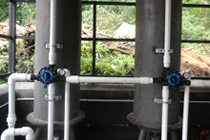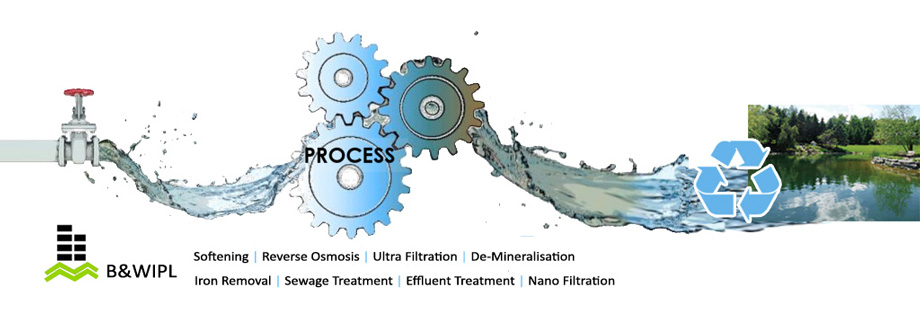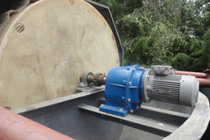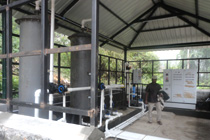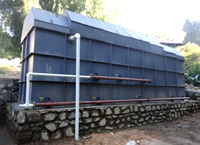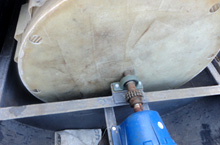A rotating biological contactor or RBC is a biological treatment process used in the treatment of wastewater following treatment. The primary treatment process re-moves the grit and other solids through a screening process followed by a period of settlement. The RBC process involves allowing the wastewater to come in contact with a biological medium in order to remove pollutants in the wastewater before dis-charge of the treated wastewater to the environment, usually a body of water (river, lake or ocean). A rotating biological contactor is a type of secondary treatment process. It consists of a series of closely spaced, parallel discs mounted on a rotating shaft, which is supported just above the surface of the wastewater. Microorganisms grow on the surface of the discs where biological degradation of the wastewater pollutants takes place.
The rotating packs of disks (known as the media) are contained in a tank or trough and rotate at between 2 and 5 revolutions per minute. Commonly used plastics for the media are polythene, PVC and expanded polystyrene. The shaft is aligned with the flow of wastewater so that the discs rotate at right angles to the flow with several packs usually combined to make up a treatment train. About 40% of the disc area is immersed in the wastewater.
Biological growth is attached to the surface of the disc and forms a slime layer. The discs contact the wastewater with the atmospheric air for oxidation as it rotates. The rotation helps to slough off excess solids. The disc system can be staged in series to obtain nearly any detention time or degree of removal required. Since the systems are staged, the culture of the later stages can be acclimated to the slowly degraded materials.
The discs consist of plastic sheets ranging from 2 to 4 m in diameter and are up to 10 mm thick. Several modules may be arranged in parallel and/or in series to meet the flow and treatment requirements. The discs are submerged in waste water to about 40% of their diameter. Approximately 95% of the surface area is thus alternately sub-merged in waste water and then exposed to the atmosphere above the liquid. Carbonaceous substrate is removed in the initial stage of RBC. Carbon conversion may be completed in the first stage of a series of modules, with nitrification being completed after the 5th stage. Most design of RBC systems will include a minimum of 4 or 5 modules in series to obtain nitrification of waste water.
Biofilms, which are biological growths that become attached to the discs, assimi-late the organic materials in the wastewater. Aeration is provided by the rotating action, which exposes the media to the air after contacting them with the wastewater, facilitating the degradation of the pollutants being removed. The degree of wastewater treatment is related to the amount of media surface area and the quality and volume of the inflowing wastewater.
Secondary clarifier: Secondary clarifiers following RBCs are identical in design to conventional humus tanks, as used downstream lamella plates. Sludge is generally removed daily, or pumped automatically to the primary settlement tank for co-settlement. Regular sludge removal reduces the risk of anaerobic conditions from developing within the sludge, with subsequent sludge flotation due to the release of gases. Short contact periods are required because of the large active surface. RBCs are capable of handling a wide range of flows. Sloughed biomass generally has good settling characteristics and can easily be separated from the waste stream. Operating costs are low because little skill is required in plant operation. Short retention time. Low power requirements. Elimination of the channeling to which conventional percolators are susceptible. Low sludge production and excellent process control.
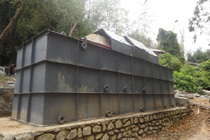
- In built complete single packaged system including collection tank and treated water tank.
- Low noise level during operation, the noise level decibels will be less than 20.
- No, stinking or bad odor during operation.
- The entire packaged unit can be transported or shifted from one location to another.
- The system can be easily upgraded from one capacity to another capacity by additional of module.
- Minimal civil work is required at site.
- Minimal Electro mechanical gadgets required for installation.
- Low operation and maintenance cost.
- Material of construction is mild steel lined with FRP, which will Increase the durability of system for long lasting.
- The customized system can be fabricated according to the site requirement as we have the manufacturing unit available with us.
- The systems do not require skilled manpower to operate; also it can be operated with minimal manpower compared to the conventional system.
- The entire unit consumes only 1 /2TH of manpower required, as compared to the conventional system.
- The moving and mechanical spares are easily available in local market
- It has inbuilt sludge storage tank and the sludge can be stored up to 6 months.
- Daily de-sludge process is not required for this system as compared with convention al system.
- It requires on 1 /2TH of the space required as compared to conventional system.
- Rotatory Biological Contractor process is proven technology available worldwide since 18th century.
- The RBC system has both primary and secondary clarifier mechanism as lamella clarifier which increases the settling mechanism better.
- The entire unit is covered and it will not have any ugly look.
- The RBC STP will have minimal consumables to operate this system do not require any other consumable except Sodium Hypo Chlorite.
- The electrical power consumption will less and it will consume only 1 /4THof the power as compared with conventional or civil based STP.
